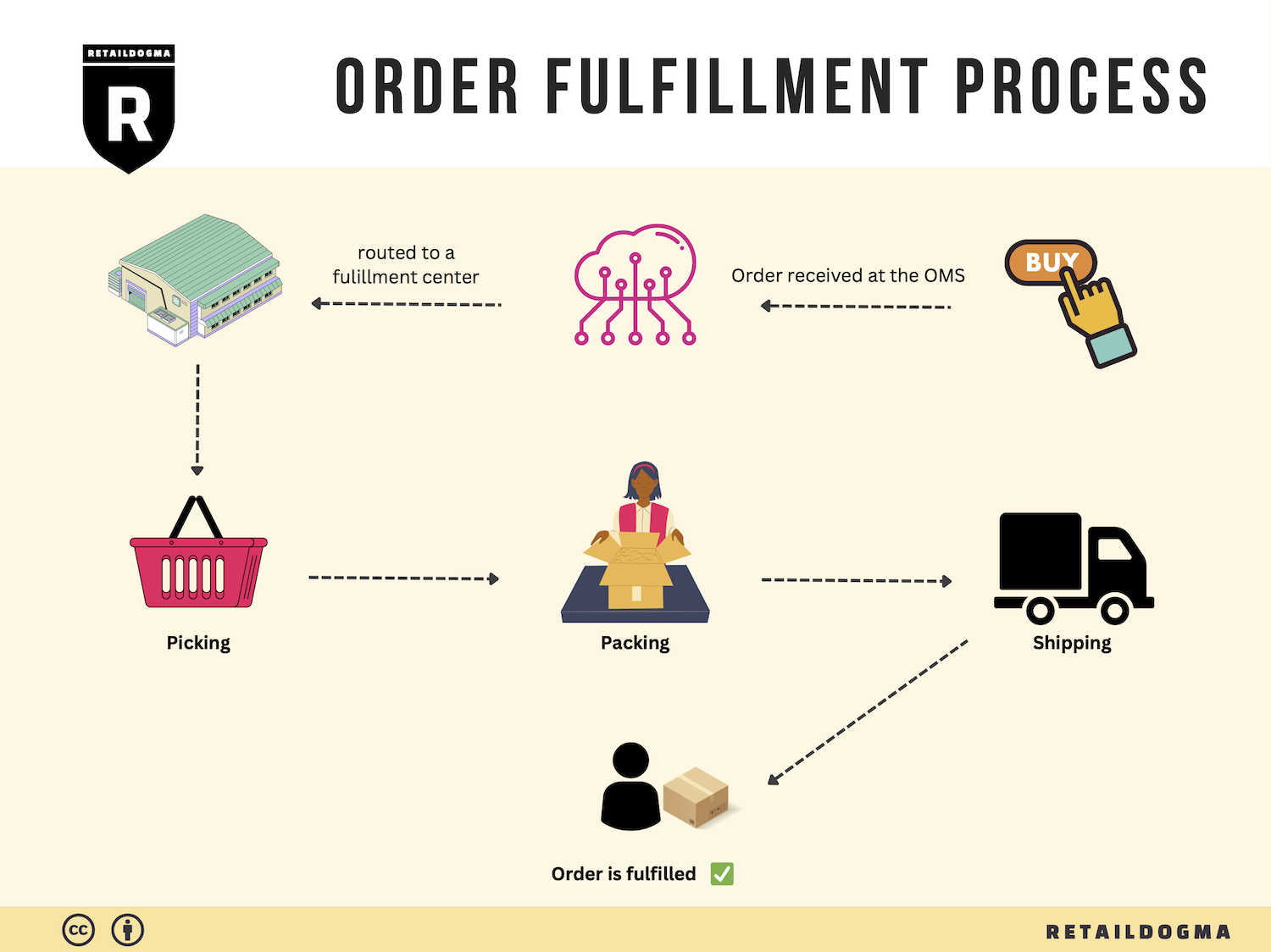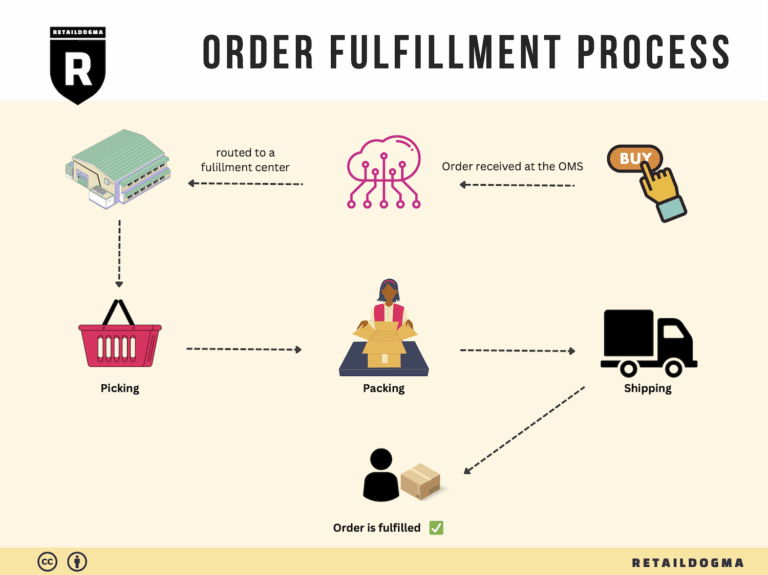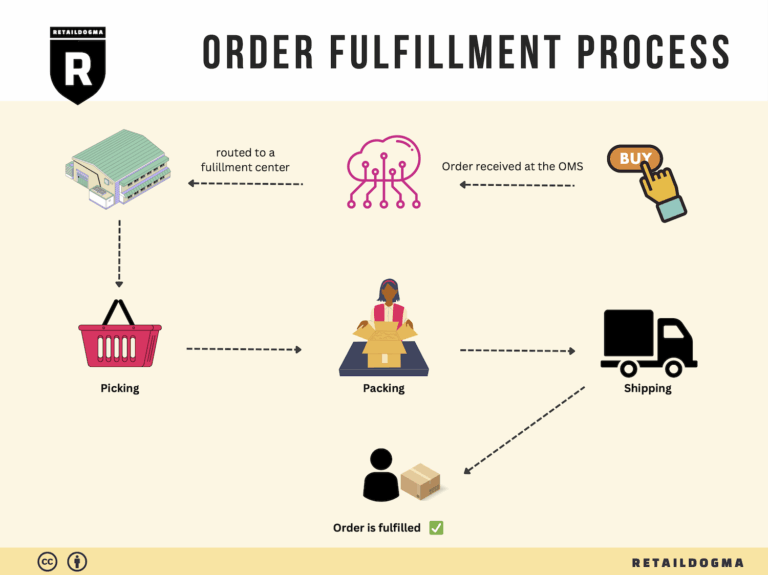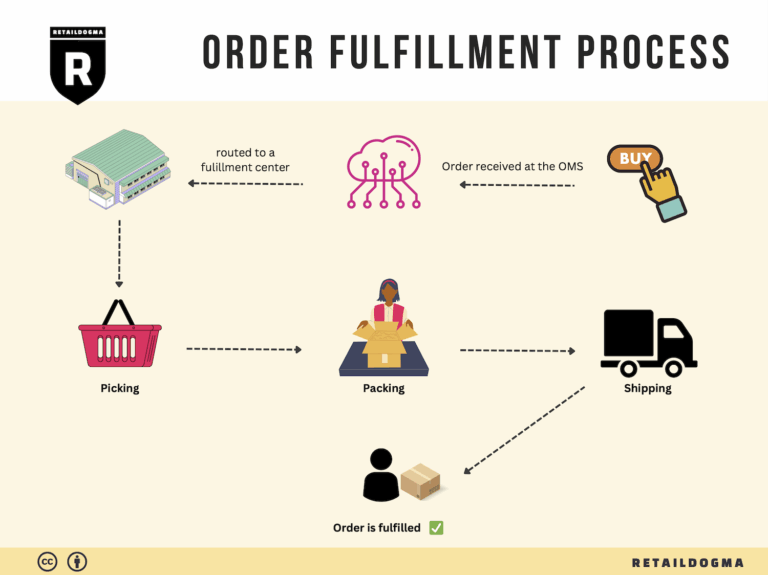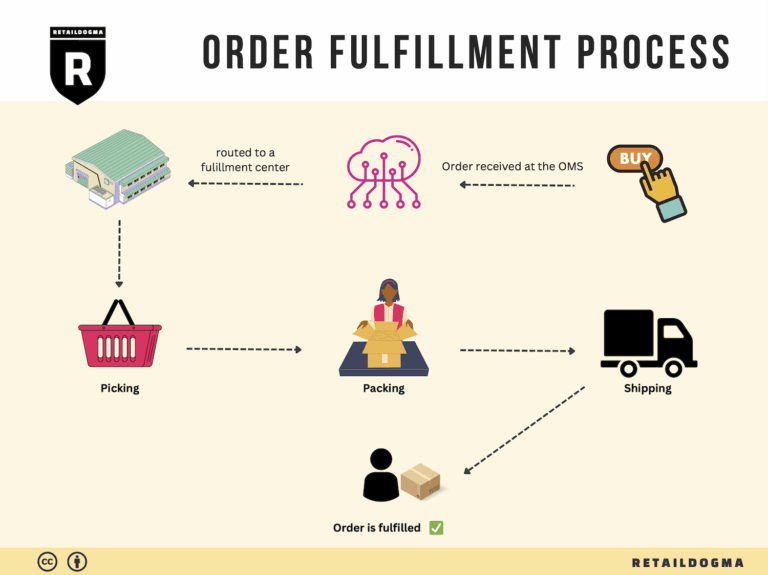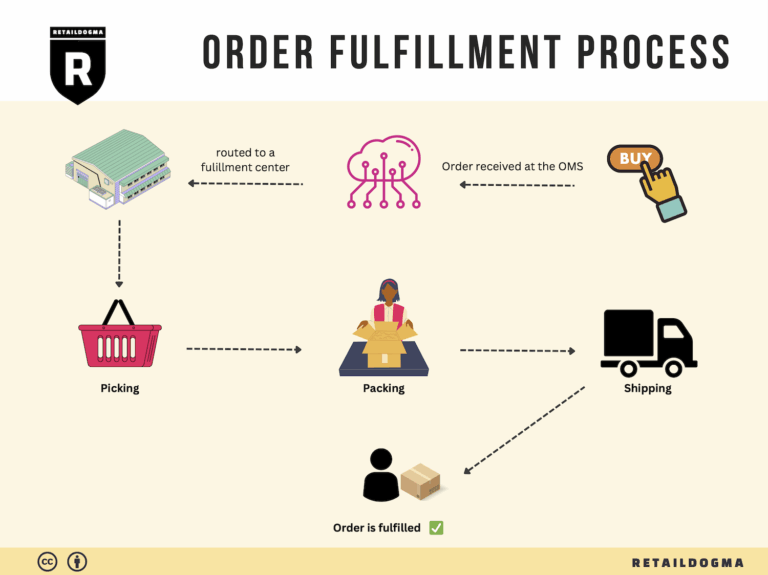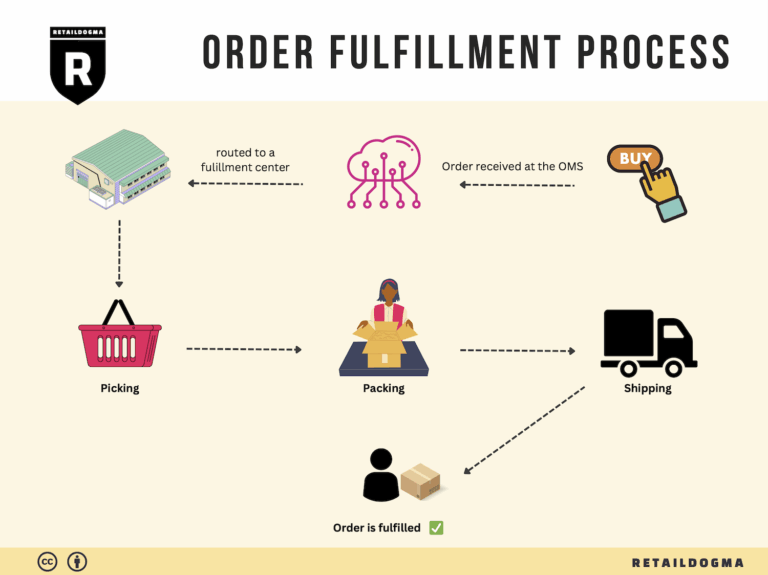Ecommerce Fulfillment Services: The Ultimate Guide (2025)
What is E-commerce Fulfillment? An Introduction for Growing Businesses
Understanding E-commerce Fulfillment
As an e-commerce business owner, you may find yourself overwhelmed by the demands of packing and shipping orders. This is a common pain point for many growing businesses; the excitement of sales can quickly turn into a logistical nightmare. Efficient fulfillment is crucial not only for customer satisfaction but also for maintaining your operational sanity. So, what exactly is fulfillment? At its core, e-commerce fulfillment refers to the complete process of getting a product into the hands of a customer, from the moment an order is placed to the final delivery.
In this guide, we will explore various aspects of e-commerce fulfillment to help you streamline your logistics. We will delve into different fulfillment models, such as Third-Party Logistics (3PL) and Fulfillment by Amazon (FBA). Each model has its own set of advantages and challenges, and understanding them will enable you to choose the right option for your business.
Additionally, we will cover the core services associated with fulfillment, including inventory management, order processing, packing, shipping, and returns handling. Each of these components plays a vital role in ensuring that your customers receive their orders promptly and in excellent condition.
Choosing the right fulfillment partner is a critical decision that can significantly impact your business. We will provide practical tips on what to look for when selecting a logistics partner, including their technology capabilities, experience, and customer service quality.
Cost is another important factor that cannot be overlooked. We will discuss how fulfillment pricing works, including common fee structures and what you should expect to pay based on your specific needs. Understanding these costs will allow you to budget effectively and maximize your profit margins.
Ultimately, the goal of this guide is to empower you to make informed decisions about your logistics strategy. By equipping yourself with knowledge about e-commerce fulfillment, you can enhance your operational efficiency, improve customer satisfaction, and position your business for scalable growth. Whether you’re just starting out or looking to optimize your existing processes, this guide will serve as a valuable resource on your journey to fulfillment excellence.

What You’ll Learn In This Guide
- What is E-commerce Fulfillment? An Introduction for Growing Businesses
- The Order Fulfillment Process: From ‘Buy’ Button to Customer’s Door
- Comparing Fulfillment Models: In-House vs. 3PL vs. Dropshipping
- A Deep Dive into Amazon FBA: Pros, Cons, and Who It’s For
- Core Services Offered by Fulfillment Centers
- How to Choose a Fulfillment Partner: A 6-Point Checklist
- Understanding Fulfillment Pricing: A Breakdown of Common Fees
- Frequently Asked Questions (FAQs) about Fulfillment
- Conclusion: Is Outsourcing Fulfillment the Right Move for Your Business?
- Important Disclaimer
The Order Fulfillment Process: From ‘Buy’ Button to Customer’s Door
1. Receiving Inventory
The order fulfillment process begins with receiving inventory at the fulfillment center. This step involves the physical arrival of products from suppliers or manufacturers. Upon arrival, each shipment is checked against the purchase order to ensure accuracy. Key terms associated with this step include SKU (Stock Keeping Unit), which is a unique identifier used to track inventory.
Importance: Efficient receiving is crucial because it sets the tone for the entire fulfillment process. Any discrepancies or damages identified at this stage can lead to delays later on. Properly received inventory also ensures that stock levels are accurately recorded in your system, preventing stockouts or overstock situations.
2. Warehouse Storage
Once inventory is received and verified, it is then stored within the warehouse. This step involves organizing products in a systematic manner, often using storage methods such as shelving, pallet racks, or bins. The layout of the warehouse is designed for optimal space utilization and ease of access. Key terms include location codes, which help in identifying where each SKU is stored.
Importance: Effective warehouse storage directly impacts the speed of order processing. A well-organized warehouse minimizes the time spent searching for products, thus enhancing overall efficiency. Moreover, maintaining accurate inventory records during this stage helps in forecasting demand and managing stock levels effectively.
3. Order Picking
When a customer places an order, the next step is order picking, where items are selected from their storage locations. This process can be executed through various methods, including batch picking, zone picking, or wave picking. A pick list is generated, which details the items and their locations in the warehouse.
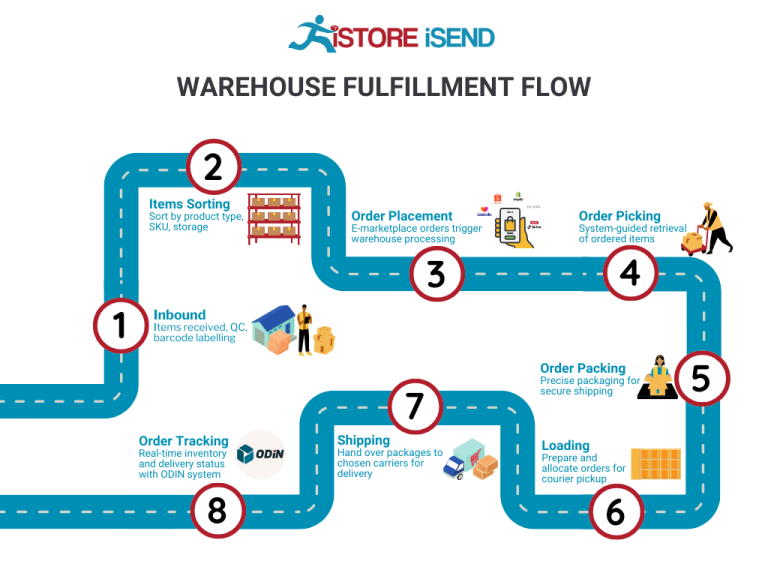
Importance: The accuracy and speed of order picking are critical for customer satisfaction. Mistakes in this phase can lead to incorrect shipments, which not only frustrate customers but also incur additional costs for returns and re-shipments. Efficient picking processes, such as utilizing technology like barcode scanners, can significantly reduce errors and improve productivity.
4. Order Packing
After items are picked, they move to the packing station. During this step, products are carefully packed into boxes for shipment. This involves selecting the appropriate packaging materials, ensuring items are secure, and labeling the packages correctly. Key terms related to this step include packing slips, which accompany the shipment and provide essential details about the order.
Importance: Packing is vital for ensuring that products arrive at the customer’s door in perfect condition. Proper packing minimizes damage during transit and enhances the unboxing experience for customers. Additionally, accurate labeling is essential for efficient shipping and tracking, directly impacting the delivery process.
5. Shipping & Delivery
The final step in the order fulfillment process is shipping and delivery. Once packed, orders are loaded onto delivery vehicles, and the shipment is dispatched to the customer. This stage includes choosing the right shipping carrier based on cost, speed, and reliability. Key terms here include last-mile delivery, which refers to the final leg of the delivery process.
Importance: The shipping and delivery phase is often the most visible part of the fulfillment process for customers. Timely and accurate delivery can significantly enhance customer satisfaction and loyalty. Businesses must also manage shipping costs effectively to maintain profitability, making it essential to regularly evaluate carrier performance and shipping strategies.
Conclusion
Understanding and optimizing each step of the order fulfillment process is crucial for e-commerce businesses aiming to scale. By focusing on efficient receiving, organized storage, accurate picking, careful packing, and reliable shipping, businesses can not only improve operational efficiency but also enhance customer satisfaction, setting the stage for growth and success in the competitive e-commerce landscape.

Comparing Fulfillment Models: In-House vs. 3PL vs. Dropshipping
Fulfillment Model Comparison
| Model | Who Handles Inventory | Best For (Business Stage) | Key Advantage | Key Disadvantage |
|---|---|---|---|---|
| In-House Fulfillment | Business Owner | Established businesses | Full control over operations | High overhead costs |
| Third-Party Logistics (3PL) | 3PL Provider | Growing businesses | Scalable and flexible solutions | Less control over inventory management |
| Dropshipping | Supplier | Startups and small businesses | Low startup costs | Lower profit margins |
In-House Fulfillment
In-house fulfillment involves managing your own warehousing and logistics operations. This model is most suitable for established businesses with the resources to invest in a dedicated fulfillment infrastructure. By controlling the entire process—from inventory management to order processing—business owners can ensure a high level of service and responsiveness to customer needs. This model allows for customization in packaging, branding, and shipping options, which can enhance the customer experience. However, it comes with significant overhead costs related to staffing, warehousing, and technology investments. Additionally, managing logistics can divert focus from core business activities, making it crucial for businesses to assess their capabilities and resources before committing to this model.
Third-Party Logistics (3PL)
Third-party logistics (3PL) providers offer businesses the opportunity to outsource their fulfillment needs to specialized companies. This model is ideal for growing businesses that need scalable solutions without the burden of managing logistics in-house. 3PLs can handle everything from warehousing and inventory management to shipping and returns, allowing businesses to focus on sales and customer service. A key advantage of using a 3PL is the flexibility it provides; businesses can easily adjust their logistics strategy based on demand fluctuations. However, working with a 3PL can lead to less control over inventory management and customer service, as businesses rely on an external provider to meet their fulfillment needs. Selecting a reputable and responsive 3PL partner is crucial to mitigate these risks and ensure a seamless customer experience.
Dropshipping
Dropshipping is a fulfillment model where the retailer does not keep goods in stock but instead transfers customer orders directly to a supplier, who then ships the products to the customer. This model is particularly advantageous for startups and small businesses with limited capital, as it requires minimal upfront investment in inventory and reduces financial risk. Entrepreneurs can offer a wide range of products without the need for warehousing, which simplifies operations significantly. However, dropshipping typically comes with lower profit margins, as suppliers often charge higher prices for the convenience of handling logistics. Additionally, businesses have limited control over inventory levels and shipping times, which can lead to customer dissatisfaction if not managed properly. Entrepreneurs must carefully vet suppliers to ensure product quality and reliability, as the success of the business hinges on third-party performance.
Conclusion
Choosing the right fulfillment model is a critical decision that can significantly impact an e-commerce business’s efficiency and customer satisfaction. Each model has its own set of advantages and disadvantages that should be carefully weighed against the business’s current stage, resources, and long-term goals. In-house fulfillment provides complete control but requires substantial investment, while 3PL offers scalability and expertise at the cost of some control. Dropshipping minimizes financial risk and operational complexity but can compromise profit margins and customer experience. By understanding the nuances of each model, business owners can make informed decisions that align with their operational capabilities and market demands.
A Deep Dive into Amazon FBA: Pros, Cons, and Who It’s For
Understanding Fulfillment by Amazon (FBA)
Fulfillment by Amazon (FBA) is a service provided by Amazon that enables e-commerce sellers to store their products in Amazon’s fulfillment centers. Amazon takes care of storage, packaging, and shipping, allowing sellers to focus on other aspects of their business. This service is particularly attractive to e-commerce entrepreneurs looking to scale their operations without the overhead of managing their own logistics.
When a customer orders a product from an FBA seller, Amazon handles the entire fulfillment process. This includes picking the product from the warehouse, packing it, and shipping it directly to the customer. Additionally, Amazon takes care of customer service and returns, which adds convenience for both sellers and buyers.
How FBA Works
-
Setting Up Your Account: To start using FBA, sellers must first create an Amazon Seller account. Once the account is set up, sellers can select the FBA option for their listings.
-
Shipping Inventory to Amazon: Sellers prepare their products and ship them to Amazon’s fulfillment centers. Amazon provides guidelines on packaging and labeling to ensure that the items are received and processed efficiently.
-
Storage and Inventory Management: Once the inventory is received, Amazon stores it in its warehouses. Sellers can monitor their inventory levels through the Seller Central dashboard.
-
Order Fulfillment: When a customer places an order, Amazon picks, packs, and ships the item on behalf of the seller. The seller benefits from Amazon’s vast logistics network, which often results in faster delivery times.
-
Customer Service and Returns: Amazon handles all customer inquiries and manages returns. This service allows sellers to provide a high level of customer service without the associated workload.
Pros of Using FBA
-
Prime Eligibility: Products fulfilled by Amazon are eligible for Amazon Prime, which significantly increases visibility and attractiveness to customers who prioritize fast shipping.
-
Customer Trust: Amazon’s reputation for reliability and customer service extends to FBA sellers. Customers are more likely to purchase from sellers who use FBA due to the trust associated with the Amazon brand.
-
Multi-Channel Fulfillment: FBA supports multi-channel fulfillment, allowing sellers to fulfill orders from their own website or other platforms using Amazon’s logistics. This flexibility can help businesses streamline their operations.
-
Scalability: FBA allows businesses to scale quickly without the need for substantial investment in warehousing or logistics infrastructure. Sellers can leverage Amazon’s extensive network to reach a larger customer base.
-
Time Savings: By outsourcing fulfillment and customer service to Amazon, sellers can focus on marketing, product development, and other strategic aspects of their business.
Cons of Using FBA
-
High Fees: FBA comes with various fees, including storage fees for keeping inventory in Amazon’s warehouses and fulfillment fees for picking, packing, and shipping. These costs can add up, especially for low-margin products.
-
Strict Inventory Rules: Amazon has stringent rules regarding inventory management, including limits on how much stock can be stored in their warehouses. This can pose challenges for sellers with fluctuating demand.
-
Commingling Risks: FBA often involves commingling inventory, meaning that products from different sellers may be stored together. This can lead to issues if a seller’s product is damaged or misrepresented by another seller’s inventory.
-
Loss of Control: By relying on Amazon for fulfillment, sellers may lose some control over the customer experience, including packaging and branding. This can dilute brand identity and customer loyalty.
-
Long Wait Times: Some sellers have reported long wait times for inventory to be processed and made available for sale, which can be detrimental to sales, especially during peak seasons.
Who is FBA Best For?
FBA is ideally suited for a variety of e-commerce businesses:
-
Small to Medium-Sized Sellers: Those looking to scale quickly without investing heavily in logistics infrastructure will find FBA to be a cost-effective solution.
-
Sellers with High Demand Products: Businesses that offer popular products that can benefit from Amazon’s Prime membership and fast shipping capabilities will likely see increased sales through FBA.
-
Brands Seeking Trust: Sellers who want to leverage Amazon’s brand reputation and customer service capabilities will benefit from the credibility that comes with using FBA.
-
Multi-Channel Retailers: Brands that sell on multiple platforms (e.g., their own website, eBay, etc.) and want to streamline their fulfillment processes will find FBA’s multi-channel fulfillment options advantageous.
-
Entrepreneurs Focused on Growth: Those looking to focus on marketing and product development rather than logistics will find FBA to be an excellent solution for managing their fulfillment needs.
In conclusion, Fulfillment by Amazon provides a robust platform for e-commerce businesses to scale effectively. While there are notable pros and cons, the service can significantly enhance operational efficiency and customer satisfaction for the right sellers. By understanding both the benefits and challenges, e-commerce entrepreneurs can make informed decisions about whether FBA aligns with their business goals.
Core Services Offered by Fulfillment Centers
Inventory Management & Warehousing
Inventory management and warehousing are foundational services provided by fulfillment centers. This involves the systematic tracking and storage of inventory, ensuring that products are stored efficiently and are easily accessible for order fulfillment.
For e-commerce businesses, effective inventory management is crucial. It helps maintain optimal stock levels, preventing both overstock and stockouts. Fulfillment centers utilize advanced inventory management systems that offer real-time tracking and reporting, which enables business owners to make informed decisions about purchasing and stocking. This service minimizes the risk of lost sales due to inventory shortages and reduces excess inventory costs, allowing businesses to operate more leanly and respond quickly to market demands.
Additionally, warehousing services often include climate control, security measures, and organized shelving, all of which protect products and enhance operational efficiency. By outsourcing these functions, e-commerce businesses can focus on growth and strategy rather than day-to-day logistics.
Pick and Pack Services
Pick and pack services refer to the process of selecting items from inventory (picking) and then preparing them for shipment (packing). Fulfillment centers employ skilled staff and advanced technology to ensure that orders are accurately picked and efficiently packed according to specific customer requirements.
This service is particularly beneficial for e-commerce businesses looking to scale. With the ability to process large volumes of orders quickly and accurately, fulfillment centers can help reduce lead times and enhance customer satisfaction. Customers today expect fast and reliable delivery, and effective pick and pack services can significantly improve a company’s ability to meet these expectations.
Moreover, fulfillment centers often implement quality control checks during the pick and pack process, ensuring that the correct items are shipped and reducing the likelihood of returns due to errors. This not only enhances customer trust but also minimizes the costs associated with returns and reshipments.
Kitting and Assembly
Kitting and assembly involve the grouping of individual items into ready-to-ship sets or the assembly of products before they are sent to customers. This service is particularly valuable for businesses that offer bundled products or require assembly before shipping, such as electronics or furniture.
For e-commerce businesses, kitting can streamline operations and enhance product offerings. By providing customers with pre-assembled kits or bundled products, companies can create unique selling propositions that differentiate them from competitors. This can lead to increased sales and higher average order values.
Additionally, kitting services can help reduce shipping costs. By consolidating multiple items into a single package, businesses can often save on shipping fees and improve overall logistics efficiency. This service also enables businesses to focus on their core competencies while leaving the complexities of assembly and packaging to the fulfillment center.
Returns Management (Reverse Logistics)
Returns management, often referred to as reverse logistics, encompasses the processes involved in handling returned merchandise. This service is vital for e-commerce businesses, as the ability to manage returns efficiently can significantly impact customer satisfaction and operational costs.
A well-structured returns management system allows businesses to process returns quickly and effectively, minimizing the time and resources spent on handling these transactions. Fulfillment centers typically manage the entire returns process, from receiving returned items to inspecting and restocking products.
This service not only helps maintain inventory accuracy but also provides valuable insights into product performance and customer preferences. By analyzing return data, businesses can identify trends, improve product quality, and enhance customer experiences, ultimately leading to better retention rates and brand loyalty.
In addition, efficient returns management can improve cash flow. By quickly restocking and reselling returned items, businesses can recover lost revenue and reduce the financial impact of returns. This is especially crucial in the competitive e-commerce landscape, where customer expectations for hassle-free returns are high.
By leveraging these core services offered by fulfillment centers, e-commerce businesses can scale operations effectively, enhance customer satisfaction, and ultimately drive growth. These services allow entrepreneurs and operations managers to focus on strategic initiatives while ensuring that the logistics side of their business runs smoothly and efficiently.
How to Choose a Fulfillment Partner: A 6-Point Checklist
Location & Warehouse Network
Importance:
The geographical location of your fulfillment partner’s warehouses can significantly impact shipping times and costs. A well-placed fulfillment center reduces transit times to your customers and can optimize shipping costs, especially for e-commerce businesses that rely on fast delivery.
Questions to Ask:
– Where are your fulfillment centers located, and how does that align with my target customer base?
– Do you have a network of warehouses that can provide coverage in key regions?
– How do you manage inventory across multiple locations to ensure stock availability?
Technology & Integrations
Importance:
In today’s e-commerce landscape, technology plays a critical role in efficiency and customer satisfaction. A good fulfillment partner should have robust technology that can integrate seamlessly with your e-commerce platform, provide real-time inventory tracking, and offer analytics for performance monitoring.
Questions to Ask:
– What technology do you use for inventory management and order processing?
– Can your system integrate with my existing e-commerce platform (e.g., Shopify, WooCommerce)?
– Do you provide real-time tracking for both inventory and shipments?
– How do you ensure data security and compliance with regulations?
Specializations (e.g., Cold Storage, Oversized Items)
Importance:
Depending on the nature of your products, you may require specialized services such as cold storage for perishables or handling oversized items. A fulfillment partner that specializes in your product type can ensure proper handling and storage conditions.
Questions to Ask:
– Do you have specialized facilities for products that require temperature control or unique handling?
– What experience do you have in managing the specific needs of my product type?
– How do you handle returns for specialized products?
Scalability & Capacity
Importance:
As your business grows, your fulfillment needs will change. A partner should have the ability to scale operations quickly to accommodate seasonal spikes in demand or long-term growth. This includes having adequate space and resources to manage increased order volumes without compromising service levels.
Questions to Ask:
– How do you handle fluctuations in order volume, especially during peak seasons?
– What is your current capacity, and how quickly can you scale up operations if my business grows?
– Can you provide examples of how you have successfully scaled for other clients?
Pricing and Contracts
Importance:
Understanding the pricing structure and contractual obligations is essential to avoid unexpected costs. Look for transparency in pricing and ensure that you understand all associated fees, including storage, shipping, and handling charges.
Questions to Ask:
– What is your pricing model (e.g., per order, per item, flat rate)?
– Are there additional fees I should be aware of (e.g., for storage, returns, or special handling)?
– What is the length of your contract, and are there penalties for early termination?
– Can you provide a detailed breakdown of costs for my specific business model?
Customer Support & Reviews
Importance:
Exceptional customer support can make a significant difference in your fulfillment experience. A responsive partner can help resolve issues quickly, ensuring minimal disruption to your operations. Additionally, customer reviews can provide insights into the reliability and quality of service.
Questions to Ask:
– What levels of customer support do you offer (e.g., dedicated account manager, 24/7 support)?
– How do you handle issues related to order fulfillment or shipping errors?
– Can you provide references or case studies from current or past clients?
– What do online reviews say about your services, and how do you respond to negative feedback?
Conclusion
Choosing the right fulfillment partner is a crucial decision that can impact your e-commerce business’s efficiency, customer satisfaction, and ultimately, your bottom line. By utilizing this checklist, you can ensure that you evaluate potential partners comprehensively, aligning their capabilities with your business needs. Taking the time to ask the right questions and assess these key areas will help you find a partner that not only meets your current requirements but can also grow alongside your business.
Understanding Fulfillment Pricing: A Breakdown of Common Fees
Initial Setup Fees
When you first partner with a fulfillment center, you may incur initial setup fees. These fees can include the cost of creating your account, integrating your e-commerce platform with the fulfillment system, and configuring your inventory management settings. Some fulfillment centers may also charge for onboarding sessions or training for your team on how to use their systems effectively.
How It’s Calculated:
Initial setup fees can vary widely between providers. Some may charge a flat fee, while others might base their charges on the complexity of the integration or the amount of inventory you plan to store. It’s essential to clarify these costs upfront to avoid surprises.
Receiving Fees
Receiving fees are charged when your inventory arrives at the fulfillment center. This fee covers the labor and resources required to unload, inspect, and stock your products. The process can vary depending on the type and volume of goods being received, as well as the efficiency of the center’s operations.
How It’s Calculated:
Typically, receiving fees are calculated based on the number of pallets or units received. Some centers may offer tiered pricing, where the cost per unit decreases as the volume of received goods increases. Be aware that additional charges may apply for special handling or if your products require extra time to check in due to discrepancies or damage.
Storage Fees (per pallet/bin)
Storage fees are incurred for the time your inventory spends in the fulfillment center. These fees are charged based on the space your products occupy, usually calculated on a per-pallet or per-bin basis. This is a crucial cost to consider, especially for businesses with seasonal inventory or fluctuating stock levels.
How It’s Calculated:
Storage fees are often billed monthly and can vary depending on the fulfillment center’s pricing model. Some centers charge a flat monthly fee per pallet, while others may have a tiered system based on the volume of goods stored. Additionally, be aware of potential long-term storage fees, which can kick in if your inventory remains in the warehouse for an extended period, often six months or more.
Pick & Pack Fees (per item/order)
Pick and pack fees are charged for the process of selecting items from storage and packing them for shipment. This fee typically covers labor costs associated with picking the items, packing them, and preparing them for delivery. The efficiency of the fulfillment center can significantly impact these fees, as centers with advanced technology may process orders more quickly.
How It’s Calculated:
Pick and pack fees can be charged per order or per item, depending on the fulfillment provider. Some centers may have a base fee for each order, with additional costs for each item included in that order. Understanding this structure is vital, especially if your product range is extensive or if you often fulfill small orders.
Shipping Fees
Shipping fees are one of the most significant costs associated with fulfillment services. These fees cover the transportation of your packed orders to customers. Factors influencing shipping costs include the shipping method chosen (e.g., standard, expedited), package dimensions, weight, and destination.
How It’s Calculated:
Shipping fees can vary based on the carrier used (e.g., USPS, FedEx, UPS), the service level selected, and any negotiated rates the fulfillment center may have with carriers. Many fulfillment centers offer shipping calculators that allow you to estimate costs based on these variables. Additionally, some providers may have flat rates for specific shipping methods or regions.
Tips for Getting an Accurate Quote
-
Understand Your Needs: Clearly define your inventory volume, types of products, and expected order volume. This information is crucial for accurate pricing.
-
Request Detailed Breakdowns: Ask potential fulfillment partners for a comprehensive breakdown of all fees, including any additional charges that may apply under specific circumstances.
-
Negotiate Rates: Don’t hesitate to negotiate rates, especially if you anticipate significant volume. Many fulfillment centers are willing to provide discounts for larger orders or longer-term contracts.
-
Compare Multiple Providers: Get quotes from multiple fulfillment centers to understand the market rates and identify the best options for your business.
-
Consider Hidden Costs: Be aware of potential hidden costs, such as fees for returns, special handling, or storage of seasonal inventory. Understanding all possible charges will help you make a more informed decision.
By being diligent in understanding and negotiating fulfillment pricing, you can ensure that your logistics operations are both cost-effective and scalable, positioning your business for growth in the competitive e-commerce landscape.
Frequently Asked Questions (FAQs) about Fulfillment
1. What is the address of Amazon Fulfillment Center CHA2?
The Amazon Fulfillment Center CHA2 is located at 225 Infinity Dr, Charleston, TN 37310, United States.
2. What are the typical wait times for deliveries at the CHA2 fulfillment center?
Wait times can vary significantly, with some drivers reporting delays of several hours during unloading and loading processes. It’s advisable to plan for potential delays when scheduling deliveries.
3. Is parking available for trucks at the CHA2 fulfillment center?
Yes, there is designated parking available for trucks near the facility. This allows drivers to maneuver and wait as needed during their delivery schedules.
4. How does the check-in process work at the CHA2 fulfillment center?
Check-in involves a verification process at the guard shack, where drivers must provide necessary paperwork. Be aware that this process may lead to delays, particularly during peak hours.
5. Are there job opportunities available at the CHA2 fulfillment center?
Yes, the CHA2 fulfillment center regularly hires for various positions. Interested candidates can apply online through platforms like Integrity Staffing Solutions or Amazon’s own job portal.
6. What are the main functions of a fulfillment center like CHA2?
A fulfillment center like CHA2 is primarily responsible for storing, picking, packing, and shipping products directly to customers. It differs from a warehouse, which typically focuses on storage without the order fulfillment component.
7. What is a 3PL, and how does it relate to fulfillment centers?
A 3PL, or third-party logistics provider, offers outsourced logistics services, which can include warehousing, fulfillment, and distribution. Fulfillment centers like CHA2 can operate as a 3PL for businesses looking to streamline their supply chain operations.
8. How much do fulfillment services typically cost?
Costs for fulfillment services can vary widely based on factors such as volume, storage space, and specific service requirements. It’s essential to obtain quotes from fulfillment centers to understand pricing structures and find a solution that fits your budget.
9. What safety measures are in place at CHA2 to protect drivers and cargo?
While there are ongoing concerns regarding trailer safety and maintenance, Amazon implements standard safety protocols, including regular inspections and staff training. However, drivers should remain vigilant and report any safety issues encountered.
10. What can businesses do to mitigate delays when using CHA2 for fulfillment?
To reduce potential delays, businesses should maintain clear communication with the fulfillment center regarding delivery schedules, ensure all necessary documentation is prepared in advance, and consider off-peak delivery times when scheduling pickups or drop-offs.
Conclusion: Is Outsourcing Fulfillment the Right Move for Your Business?
Evaluating the Benefits of Outsourcing Fulfillment
Outsourcing fulfillment can be a game-changer for e-commerce businesses looking to scale efficiently. By partnering with a reputable fulfillment service, companies can save significant time and resources. This allows business owners to focus on core activities such as marketing, product development, and customer engagement rather than getting bogged down in logistics.
One of the primary benefits of using a fulfillment service is scalability. As your sales volume fluctuates, a capable fulfillment partner can adjust operations to meet demand without the need for substantial investment in warehousing and staffing. This flexibility is crucial for maintaining customer satisfaction, especially during peak seasons or promotional campaigns.
Moreover, fulfillment centers bring expertise in logistics management. They are equipped with advanced technology and best practices that can optimize order processing, inventory management, and shipping efficiency. This level of specialization can lead to faster delivery times, reduced shipping costs, and improved overall operational performance.
However, the choice of fulfillment partner is critical to your success. Not all providers offer the same level of service or operational capabilities. It’s essential to conduct thorough research and consider factors such as location, technology, reliability, and customer service. A mismatched partner can lead to delays, increased costs, and ultimately, dissatisfied customers.
Call to Action: Audit Your Current Shipping Process
Before making the leap to outsourcing, take a moment to audit your current shipping and fulfillment processes. Evaluate your operational efficiency, customer feedback, and fulfillment costs. This analysis will help you determine if a fulfillment partner is the right strategic move for your business. Start exploring potential partners that align with your growth goals, and consider how they can help you enhance your logistics strategy and customer satisfaction.
Important Disclaimer
⚠️ Important Disclaimer
The information in this guide is for educational purposes. Fulfillment services, pricing, and platform features change frequently. Always conduct your own due diligence and consult with providers directly before making business decisions.
